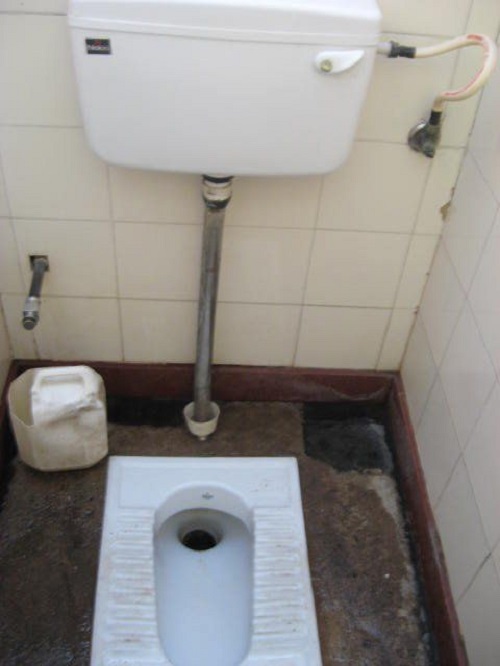Western tourists are often left perplexed by the cultural differences in their travel destinations. For instance, the realization that many people across the world squat to poop can be bewildering to a westerner. Today, we’ll be talking about the Indian toilet.
The Indian toilet, despite its name, is not exclusive to the South Asian nation. About two-thirds of the world’s population uses some variation of this toilet. They are also common in other Asian countries, the Middle East, Africa, and other parts of the world — especially in rural areas.
What Is the Indian Toilet?
An Indian toilet, also known as a squat toilet, consists of a bowl or pan and a place to put your feet on each side flush against the floor. To use this toilet, you have to squat, as opposed to sitting on a toilet seat.
There are a few variations of the Indian toilet, but they all consist essentially of a hole in the ground connected to a drainage system.
How To Use an Indian Toilet
Indian or squat toilets are incredibly easy to use. Position yourself correctly over the toilet by placing your feet on the foot pads on either side of the bowl. Next, drop your pants and bend your knees to lower yourself to a comfortable position. Flush when you are done.
To flush the contents, all you have to do is fill a bucket with water and dump it down the drain. In some parts of the world, squat toilets may have a flush system hooked to the wall, which you can flush normally by pulling a handle.
Be sure to clean yourself thoroughly when you are done. You may find no toilet paper in an Indian-style toilet, so you have to rinse yourself with water. Lastly, wash your hands with soap and water to eliminate germs and bacteria.
Why Use Indian Toilet
While most western households have traditional toilets installed, some still prefer the Indian/squat-style toilet. Here are some reasons to install a squat toilet in your home rather than a traditional/western-style toilet.
Less Strain While Pooping
Squatting to poop has a wide range of health benefits. For starters, the squatting position is really better for your body. Squatting puts your body in a natural position, providing a clearer exit for your bowel movements.
The squatting position also allows gravity to take over, reducing the strain on your muscles as you poop. Research shows that 90% of people who squat to poop strain less than those who poop with their feet on the floor.
Indian Toilet Improves Digestion
Sitting in a squat position helps the body digest food properly. When you squat to poop, your stomach is squeezed. The squat toilet design puts pressure on your stomach, which further presses, pressurizes, and churns the food in your stomach.
A traditional western-style toilet doesn’t put any pressure on your digestive tract, which can lead to incomplete bowel evacuation. Using a squat toilet daily will enhance digestion and give you more satisfying bowel movements.
More Hygienic
Squatting to poop may be considered uncivilized in the western world, but some argue it’s more hygienic. This is particularly true for public restrooms. Public toilets are often dirty, which is a concern for users.
A squat toilet ensures no contact between your body and the toilet, eliminating the risk of picking up germs when you sit on a public toilet. You don’t have to worry about UTIs and other health problems with a squat toilet.
The Indian Toilet Is More Eco-Friendly
Indian toilets also get an eco-friendly shout because, in most cases, no toilet paper is required. The entire process of producing toilet paper, from cutting trees down to using bleach and large amounts of water, harms the environment.
In parts of the world where Indian-style toilets are common, you are expected to clean yourself afterward. With toilet paper becoming less sustainable, Indian-style toilets are the most environmentally friendly option.
As you can see, the Indian toilet has a lot of advantages over the conventional western style toilet. Of course, there are a few Indian toilet disadvantages, including that they may not be convenient for older people and persons with disabilities.
Conclusion
If you take a trip to India and other parts of the world, you’ll discover that most of the global population doesn’t use western-style toilets. An Indian toilet is typically a squat toilet, consisting of a bowl or pan at ground level, with foot pads on either side of the toilet flush with the ground.
When it comes to Indian toilet vs Western toilet, it’s just a matter of preference. It also depends on where you are in the world. Outside the United States and most of Europe, the squat toilet is preferred to its western style counterpart.


